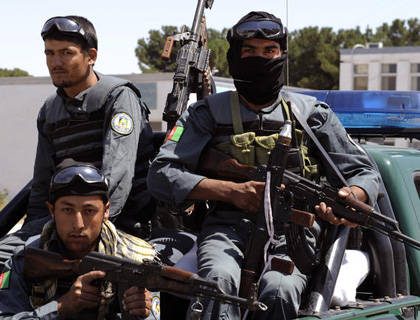KABUL - Afghan forces could soon take charge of security in all or parts of 17 of Afghanistan's 34 provinces – the second step in a transition that President Hamid Karzai hopes will leave his police and soldiers in control across the nation by the end of 2014, government officials said Wednesday. Karzai is to officially announce the new sites that are to transition from NATO to Afghan control at a Nov. 2 conference in Istanbul. In July, he announced the first seven areas to begin the transition process.
Abdul Khalik Farahi, director of the Afghan department on local governance, announced the 17 provinces at a meeting Wednesday in Kabul as the list was being fine-tuned.
The areas are mostly in northern and western Afghanistan – not the south and east where most of the fighting has been taking place. But there are locations on the list that have seen violence lately or are near to sections of the nation still controlled by the Taliban.
"Afghanistan is passing a historical moment and opening a new page of history," Farahi said.
Officials with both the Afghan government and the U.S.-led coalition have predicted that once the transition sites are approved by Karzai, 40 percent to 50 percent of the Afghan population will be living in areas where Afghan security forces have or soon will begin taking full responsibility from the coalition.
Though excited, many governors in the newly listed provinces complained that transition can't succeed unless they receive more police, soldiers and equipment.
Governor Musa Khan Akbarzada said his provincial capital of Ghazni city was on the list, but not the rest of Ghazni province in eastern Afghanistan.
"There has to be more modern equipment," said Akbarzada, a man in a long, black beard and black turban. "After the transfer, we need to have modern weapons immediately."
Abdul Jabar Taqwa, the governor of Takhar in the north who was wounded last year when a suicide bomber killed the governor of a neighboring province, echoed his complaint.
"There is a big need for police and equipment," he said, standing on the steps of the Afghan Independent Directorate of Local Governance during a break in the meeting. "A lot of appeals for more have been made."
Meanwhile, Defense Ministry spokesman Mohammad Zahir Azimi told reporters Wednesday that as soon as the second transition phase begins, the government will start moving more troops and equipment to areas that need them. He also announced that Afghan forces plan a new offensive in upcoming days in Khost, Paktika and Paktia provinces, a stronghold of the Haqqani network affiliated with al-Qaida and the Taliban.
Abdul Karim Barawi, the governor of Nimroz province in the southwest that borders Iran, said more Afghan Border Police were needed and that only 36 percent of the province's 236-kilometer border with Iran is protected, he said.
The provinces included in the second transition phase are Helmand in the south; Nimroz in the southwest; Ghor and Herat in the west; and Day Kundi in central Afghanistan. Also on the list are Balkh, Parwan, Takhar, Badghis, Sar-e-Pul, Samangan and Badakhshan in the north; and Kabul, Ghazni, Wardak, Laghman and Nangarhar in the east.
Transition is expected to take up to a year and a half in each area as NATO forces gradually take on support roles, including training and mentoring, and are redeployed to other areas of the country or sent home.
But the areas planned for transition are not insulated from violence.
On Tuesday night, a bomb hidden inside a fuel truck in Parwan province exploded, killing at least five in a relatively quiet part of the nation, officials said. The explosion took place about 25 miles (40 kilometers) north of the capital, Kabul. There was no immediate claim of responsibility.
The blast occurred as dozens had gathered around the truck to collect leaking fuel, said Kabir Ahmad, chief of Bagram district.
Khalil Farhangi, the province's hospital chief, confirmed that three people died at the scene. Kabir Amiri, who oversees all of Kabul's hospitals, said two others transported to the hospital also died and that 45 people were wounded in the blast.
Local residents claimed more than 10 people died. They said other victims' bodies were quickly recovered by relatives.
In the west, Sayed Ahmad Sadat, the intelligence chief for Faryab province, died of injuries sustained when a suicide bomber jumped in front of his vehicle on Oct. 17, deputy governor Abdul Satar Barez said Wednesday.
Sadat fought in the Afghan civil war in the 1990s and was the provincial leader of the political party led by former Afghan President Burhanuddin Rabbani. Rabbani, the head of the Afghan peace council, was assassinated last month by an assassin posing as peace envoy from the Taliban. (Agencies)

